
Mehrgarh is a Neolithic site, which lies on the Kacchi Plain of Balochistan, Pakistan. Mehrgarh is located near the Bolan Pass, to the west of the Indus River valley and between the present-day Pakistani cities of Quetta, Kalat and Sibi. The site was discovered in 1974 by an archaeological team directed by French archaeologists Jean-François Jarrige and Catherine Jarrige, and was excavated continuously between 1974 and 1986, and again from 1997 to 2000. Archaeological material has been found in six mounds, and about 32,000 artifacts have been collected. The earliest settlement at Mehrgarh—in the northeast corner of the 495-acre (2.00 km2) site—was a small farming village dated between 7000 BCE and 5500 BCE.
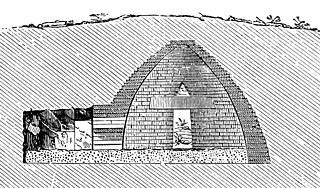
A beehive tomb, also known as a tholos tomb, is a burial structure characterized by its false dome created by corbelling, the superposition of successively smaller rings of mudbricks or, more often, stones. The resulting structure resembles a beehive, hence the traditional English name.
Shillourokambos is a Pre-Pottery Neolithic B (PPNB) site near Parekklisia, 6 km east of Limassol in southern Cyprus. It is located on a low plateau. Excavations began in 1992. The settlement has four phases and was occupied from the end of the 9th millennium to the second half of the 8th millennium.

Atlit Yam is an ancient submerged Neolithic village off the coast of Atlit, Israel. It has been carbon-dated as to be between 8,900 and 8,300 years old. Among the features of the 10-acre site is a stone circle.
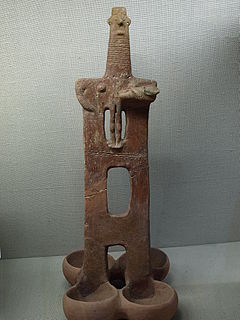
The Prehistoric Period is the oldest part of Cypriot history. This article covers the period 10,000 to 800 BC and ends immediately before any written records of civilizations, such as the first mention of Cyprus by the Romans.

The Mumun pottery period is an archaeological era in Korean prehistory that dates to approximately 1500-300 BC This period is named after the Korean name for undecorated or plain cooking and storage vessels that form a large part of the pottery assemblage over the entire length of the period, but especially 850-550 BC.

Khirokitia is an archaeological site on the island of Cyprus dating from the Neolithic age. It has been listed as a World Heritage Site by UNESCO since 1998. The site is known as one of the most important and best preserved prehistoric sites of the eastern Mediterranean. Much of its importance lies in the evidence of an organised functional society in the form of a collective settlement, with surrounding fortifications for communal protection. The Neolithic aceramic period is represented by this settlement and around 20 other similar settlements spread throughout the island.
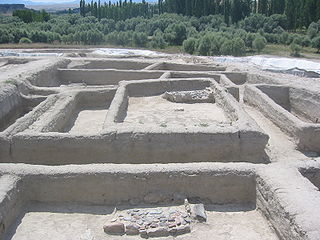
Aşıklı Höyük is a settlement mound located nearly 1 km south of Kızılkaya village on the bank of the Melendiz brook, and 25 kilometers southeast of Aksaray, Turkey. Aşıklı Höyük is located in an area covered by the volcanic tuff of central Cappadocia, in Aksaray Province. The archaeological site of Aşıklı Höyük was first settled in the Pre-Pottery Neolithic period, around 8,200 BC.
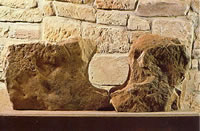
The Altendorf tomb was an important megalithic tomb at Altenburg near Naumburg, northern Hesse, Germany. It was a gallery grave belonging to the Late Neolithic Wartberg culture. The Altenburg tomb is of special significance in Central European prehistory because of the large number of individuals it contained.

The Tumulus of Bougon or Necropolis of Bougon is a group of five Neolithic barrows located in Bougon near La-Mothe-Saint-Héray, between Exoudon and Pamproux in Nouvelle-Aquitaine, France. Their discovery in 1840 raised great scientific interest. To protect the monuments, the site was acquired by the department of Deux-Sèvres in 1873. Excavations resumed in the late 1960s. The oldest structures of this prehistoric monument date to 4800 BC.

The Trundle is an Iron Age hillfort on St Roche's Hill about 4 miles (6 km) north of Chichester, Sussex, England, built on the site of a causewayed enclosure, a form of early Neolithic earthwork found in northwestern Europe. Causewayed enclosures were built in England from shortly before 3700 BC until about 3300 BC; they are characterized by the full or partial enclosure of an area with ditches that are interrupted by gaps, or causeways. Their purpose is not known; they may have been settlements, or meeting places, or ritual sites. A chapel dedicated to St Roche was built on the hill around the end of the 14th century; it was in ruins by 1570. A windmill and a beacon were subsequently built on the hill.
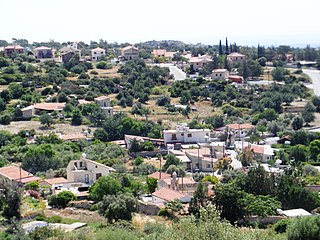
Sotira is a village located partly in the Limassol District of Cyprus, and partly in the British Overseas Territory of Akrotiri and Dhekelia, west of Limassol, near Episkopi.
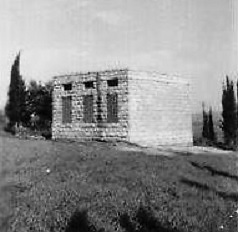
Abu Zurayq is an archaeological site named after the modern village that existed there, located on the western edge of the Jezreel Valley and its transition to the Menashe Heights. It is located next to Highway 66, between the modern kibbutzim of HaZore'a and Mishmar HaEmek.
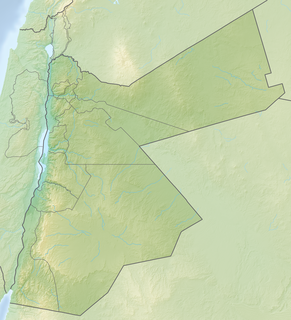
Iraq ed-Dubb, or the Cave of the Bear, is an early Neolithic archeological site 7 km (4.3 mi) northwest of Ajlun in the Jordan Valley, in modern-day Jordan. The settlement existed before 8,000 BCE and experimented with the cultivation of founder crops, side by side with the harvesting of wild cereals. Along with Tell Aswad in Syria, the site shows the earliest reference to domestic hulled barley between 10,000 and 8,800 BCE. The site is located on a forested limestone escarpment above the Wadi el-Yabis in northwest Jordan. An oval-shaped stone structure was excavated along with two burials and a variety of animal and plant remains.

Nea Nikomedeia is a village approximately 11 kilometres (6.8 mi) to the northeast of Veria in Imathia, in the region of Central Macedonia in northern Greece. It is best known for the nearby Early Neolithic settlement, one of the oldest in Europe.
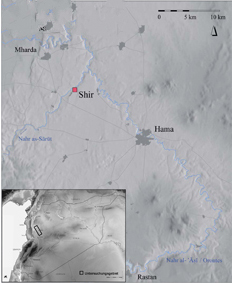
Shir is a Late Neolithic site in western Syria, located 12 km northwest of Hama, capital of the province by the same name. The settlement of Shir is situated upon a 30-m high terrace formation above the Nahr as-Sārūt, a tributary of the Orontes River.

Knap Hill lies on the northern rim of the Vale of Pewsey, in northern Wiltshire, England, about a mile north of the village of Alton Priors. At the top of the hill is a causewayed enclosure, a form of Neolithic earthwork which began to appear in England from about 3700 BC onwards, characterized by the full or partial enclosure of an area with ditches that are interrupted by gaps, or causeways. Their purpose is not known—they may have been settlements, or meeting places, or ritual sites of some kind. The site has been scheduled as an ancient monument.
Hallan Çemi Tepesi is a Protoneolithic site in south-eastern Anatolia which was discovered in 1989 and is believed to be more than 11,000 years old. Tools were made from flint and obsidian. There is evidence of malachite, a copper ore, being imported and suggesting the existence of a trading network. Staples included lentils, almonds and pistachios. Whereas sheep and goat were usually the first animals to be kept as livestock by Near East communities, it appears that Hallan Çemi began with pigs.

Halangy Down is a prehistoric settlement located on the island of St Mary's, in the Isles of Scilly. The ancient site covers the lower slope of Halangy Down hill, overlooking the coastal inlet between the island of St. Mary's and Tresco Island. On the site are the remains of an Iron Age village, two entrance graves, prehistoric field systems, standing stones, post-medieval breastworks, and a Victorian kelp pit. The settlement was in continuous use for 500 years, from the late Iron Age until the end of the Roman occupation in Britain.

H3 is an archaeological site in the Subiya Region (Kuwait) that was occupied during the second half of the sixth millennium BC. It belonged to the local Arabian Neolithic tradition and had extensive contacts with Ubaid settlements in Mesopotamia. Among the finds at the site were a boat model and pieces of bitumen covered with reed impressions that may have come from an actual boat, making this among the earliest evidence of a sea-going vessel in the world.